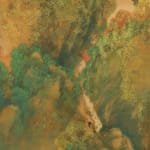Mori Getsujō (Kantarō)
Fall Colors, ca 1930s
Hanging scroll; ink and mineral pigments on silk
Overall size 87¼ x 26¼ in. (221.5 x 66.5 cm)
Image size 57 x 20 in. (144.5 x 51 cm)
Image size 57 x 20 in. (144.5 x 51 cm)
T-4929
Further images
-
(View a larger image of thumbnail 1
)

-
(View a larger image of thumbnail 2
)

-
(View a larger image of thumbnail 3
)

-
(View a larger image of thumbnail 4
)

-
(View a larger image of thumbnail 5
)

-
(View a larger image of thumbnail 6
)

-
(View a larger image of thumbnail 7
)

-
(View a larger image of thumbnail 8
)

-
(View a larger image of thumbnail 9
)

-
(View a larger image of thumbnail 10
)

-
(View a larger image of thumbnail 11
)

-
(View a larger image of thumbnail 12
)

Signed and sealed at lower right Getsujō. Comes with its original fitted paulownia-wood tomobako storage box inscribed outside Sokyō shūsai (see below); signed inside Getsujōdai (Titled by Getsujō) and signed...
Signed and sealed at lower right Getsujō.
Comes with its original fitted paulownia-wood tomobako storage box inscribed outside Sokyō shūsai (see below); signed inside Getsujōdai (Titled by Getsujō) and signed Mori Kan no in (Seal of Mori Kan[tarō])
Combining the East Asian tall hanging-scroll format, traditional Chinese perspective (where “further up” means “further away”), the bright mineral pigments that characterize Nihonga (neo-nativist painting), and elements of Western-style modeling and shading, Mori Getsujō has created a dramatic landscape that crystallizes the spirit of Japanese landscape art in the 1930s.
Mori Getsujō (birth name Kantarō) studied at the Kyoto City School of Arts before becoming an uchi-deshi (live-in pupil) of the immensely influential Kyoto painter Takeuchi Seihō (1864-1942); his loyalty to his master would later earn him the nickname “Seihō of Suma,” alluding to his birthplace to the west of the city of Kobe. Mori was first selected for the Bunten national exhibition in 1908 and would go on to show his work no fewer than twenty times at the Bunten and its successor iterations until 1944, as well as the Second Shōtoku Taishi exhibition held in 1930; in addition to painting numerous Japanese landscapes in screen and scroll format, in 1935 he also produced a series of postcard views of Taiwan. After World War II, Mori was active in promoting the arts in Hyogo Prefecture, receiving the Prefectural Arts Prize in 1952. A painting by Mori Getsujō, dating from the latter part of his career, is the collection of the Seattle Art Museum.
The location Sokyō in the title may possibly be an error for Sokei, in which case the painting’s subject might just be the area around the Oku Jisso Keikoku, a picturesque gorge on the Jisso (or Jūso) River in Kagoshima in the far south of Kyushu Island.
Comes with its original fitted paulownia-wood tomobako storage box inscribed outside Sokyō shūsai (see below); signed inside Getsujōdai (Titled by Getsujō) and signed Mori Kan no in (Seal of Mori Kan[tarō])
Combining the East Asian tall hanging-scroll format, traditional Chinese perspective (where “further up” means “further away”), the bright mineral pigments that characterize Nihonga (neo-nativist painting), and elements of Western-style modeling and shading, Mori Getsujō has created a dramatic landscape that crystallizes the spirit of Japanese landscape art in the 1930s.
Mori Getsujō (birth name Kantarō) studied at the Kyoto City School of Arts before becoming an uchi-deshi (live-in pupil) of the immensely influential Kyoto painter Takeuchi Seihō (1864-1942); his loyalty to his master would later earn him the nickname “Seihō of Suma,” alluding to his birthplace to the west of the city of Kobe. Mori was first selected for the Bunten national exhibition in 1908 and would go on to show his work no fewer than twenty times at the Bunten and its successor iterations until 1944, as well as the Second Shōtoku Taishi exhibition held in 1930; in addition to painting numerous Japanese landscapes in screen and scroll format, in 1935 he also produced a series of postcard views of Taiwan. After World War II, Mori was active in promoting the arts in Hyogo Prefecture, receiving the Prefectural Arts Prize in 1952. A painting by Mori Getsujō, dating from the latter part of his career, is the collection of the Seattle Art Museum.
The location Sokyō in the title may possibly be an error for Sokei, in which case the painting’s subject might just be the area around the Oku Jisso Keikoku, a picturesque gorge on the Jisso (or Jūso) River in Kagoshima in the far south of Kyushu Island.











